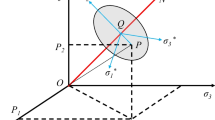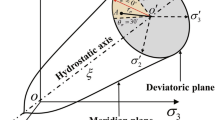Abstract
A reasonable strength criterion should reflect the hydrostatic pressure effect, minimum principal stress effect, and intermediate principal stress effect. The former two effects can be described by the meridian curves, and the last one mainly depends on the Lode angle dependence function. Among three conventional strength criteria, i.e. Mohr–Coulomb (MC), Hoek–Brown (HB), and Exponent (EP) criteria, the difference between generalized compression and extension strength of EP criterion experience a firstly increase then decrease process, and tends to be zero when hydrostatic pressure is big enough. This is in accordance with intrinsic rock strength characterization. Moreover, the critical hydrostatic pressure \(I_\mathrm{c}\) corresponding to the maximum difference of between generalized compression and extension strength can be easily adjusted by minimum principal stress influence parameter K. So, the exponent function is a more reasonable meridian curves, which well reflects the hydrostatic pressure effect and is employed to describe the generalized compression and extension strength. Meanwhile, three Lode angle dependence functions of \(L_{{\mathrm{MN}}}\), \(L_{{\mathrm{WW}}}\), and \(L_{{\mathrm{YMH}}}\), which unconditionally satisfy the convexity and differential requirements, are employed to represent the intermediate principal stress effect. Realizing the actual strength surface should be located between the generalized compression and extension surface, new true-triaxial criteria are proposed by combining the two states of EP criterion by Lode angle dependence function with a same lode angle. The proposed new true-triaxial criteria have the same strength parameters as EP criterion. Finally, 14 groups of triaxial test data are employed to validate the proposed criteria. The results show that the three new true-triaxial exponent criteria, especially the Exponent Willam-Warnke criterion (EPWW) criterion, give much lower misfits, which illustrates that the EP criterion and \(L_{{\mathrm{WW}}}\) have more reasonable meridian and deviatoric function form, respectively. The proposed new true-triaxial strength criteria can provide theoretical foundation for stability analysis and optimization of support design of rock engineering.












Similar content being viewed by others
References
Mohr, O.: Welche Umstände bedingen die Elastizitätsgrenze und den Bruch eines Materials? Zeit. des Ver. Deut. Ing. 44, 1524–1530 (1990)
Griffith, A.A.: The phenomena of rupture and flow in solids. Philos. Trans. R. Soc. A Lond. 221, 163–198 (1920)
Hoek, E., Carranza-Torres, C.T., Corkum, B.: Hoek–Brown failure criterion—2002 edition. In: Proceedings of the 5th North American Rock Mechanics Symposium and 17th Tunnelling Association of Canada Conference, Toronto, Canada, July 7–10 (2002)
You, M.Q.: True-triaxial strength criteria for rock. Int. J. Rock Mech. Min. Sci. 46, 115–127 (2009)
Mogi, K.: Experimental Rock Mechanics. Taylor & Francis, New York (2006)
Michelis, P.: Polyaxial yielding of granular rock. Eng. Mech. 111, 1049–1066 (2011)
Takahashi, M., Koide, H.: Effect of the intermediate principal stress on strength and deformation behavior of sedimentary rocks at the depth shallower than 2000 m. In: Rock at Great Depth, 1. Balkema, Rotterdam, August 30–September 2 (1989)
Chang, C., Hairnson, B.: True triaxial strength and deformability of the German Continental Deep Drilling Program (KTB) deep hole amphibolite. Geophys. Res. 105, 18999–19013 (1987)
Sriapai, T., Walsri, C., Fuenkajorn, K.: True-triaxial compressive strength of Maha Sarakham salt. Int. J. Rock Mech. Min. Sci. 61, 256–265 (2013)
Hosein, R.: New empirical polyaxial criterion for rock strength. Int. J. Rock Mech. Min. Sci. 48, 922–931 (2011)
Lu, D.C., Du, X.L.: Research on nonlinear strength and failure criterion of rock material. Chin. J. Rock Mech. Eng. 32, 2394–2408 (2013)
Zhang, Q., Wang, S.L., Ge, X.R., et al.: A modified Mohr–Coulomb strength criterion considering rock mass intrinsic material strength factorization. Min. Sci. Technol. 20, 701–706 (2010)
Lee, Y.K., Pietruszczak, S., Choi, B.H.: Failure criteria for rocks based on smooth approximations to Mohr–Coulomb and Hoek–Brown failure functions. Int. J. Rock Mech. Min. Sci. 56, 146–160 (2012)
Singh, M., Raj, A., Singh, B.: Modified Mohr–Coulomb criterion for non-linear triaxial and polyaxial strength of intact rocks. Int. J. Rock Mech. Min. Sci. 48, 546–555 (2011)
Yu, M.H.: Twin Shear Theory and Its Application. Science Press, Beijing (1998)
Zhang, L.Y., Zhu, H.H.: Three-dimensional Hoek–Brown strength criterion for rocks. J. Geotech. Geoenviron. Eng. ASCE 133, 1128–1135 (2007)
Zhang, Q., Zhu, H.H., Zhang, L.Y.: Modification of a generalized three-dimensional Hoek–Brown strength criterion. Int. J. Rock Mech. Min. Sci. 59, 80–96 (2013)
Jiang, H., Wang, X.W., Xie, Y.L.: New strength criteria for rocks under polyaxial compression. Can. Geotech. J. 48, 1233–1245 (2011)
Benz, T., Schwab, R., Kauther, R.A., et al.: A Hoek–Brown criterion with intrinsic material strength factorization. Int. J. Rock Mech. Min. Sci. 45, 210–222 (2008)
Benz, T., Schwab, R.: A quantitative comparison of six rock failure criteria. Int. J. Rock Mech. Min. Sci. 45, 1176–1186 (2008)
Liolios, P., Exadaktylos, G.: Comparison of a hyperbolic failure criterion with established failure criteria for cohesive-frictional materials. Int. J. Rock Mech. Min. Sci. 63, 12–26 (2013)
Colmenares, L.B., Zoback, M.D.: A statistical evaluation of intact rock failure criteria constrained by polyaxial test data for five different rocks. Int. J. Rock Mech. Min. Sci. 39, 695–729 (2002)
Al-Ajmi, A.M., Zimmerman, R.W.: Relation between the Mogi and the Coulomb failure criteria. Int. J. Rock Mech. Min. Sci. 42, 431–439 (2005)
Desai, C.S., Somasundaram, S., Frantziskonis, G.: A hierarchical approach for constitutive modelling of geologic materials. Int. J. Numer. Anal. Met. 10, 225–257 (1986)
Argyris, J.H., Faust, G., Szimmat, J., et al.: Recent development in the finite element analysis of pressure container reactor vessel. Nucl. Eng. Des. 28, 42–75 (1974)
Bardet, J.P.: Lode dependences for isotropic pressure sensitive elastoplastic materials. J. Appl. Mech. 57, 498–506 (1990)
Jiang, J., Pietruszczak, S.: Convexity of smooth yield surface of friction materials. Comput. Geotech. 5, 51–63 (1988)
Lade, P.V., Duncan, J.M.: Elastoplastic stress–strain theory for cohesionless soil. J. Geotech. Eng. Div. 101, 1037–1053 (1975)
Matsuoka, H., Nakai, T.: Stress-deformation and strength characteristics of soil under three different principal stress. Proc. Jpn. Soc. Civ. Eng. 232, 59–70 (1974)
Willam, K.J., Warnke, E.P.: Constitutive model for the triaxial behavior of concrete. In: International Association for Bridge and Structural Engineering, Seminar on Concrete Structure Subjected to Triaxial Stresses, Bergamo, Italy, May 17–19 (1974)
Haimson, B., Chang, C.: A new true triaxial cell for testing mechanical properties of rock, and its use to determine rock strength and deformability of Westerly granite. Int. J. Rock Mech. Min. Sci. 37, 285–296 (2000)
Wang, R.R., Kemen, J.M.R.: A New Empirical Failure Criterion for Rock Under Polyaxial Compressive Stresses. In: The 35th U.S. Symposium on Rock Mechanics, Reno, Nevada, June 5–7 (1995)
Acknowledgements
This project was supported by the National Natural Science Foundation of China (Grants 51204168, 51579239), the China Postdoctoral Science Foundation funded project (Grants 2013M531424, 2015M580493), the National Basic Research 973 Program of China (Grants 2013CB036003, 2014CB046306), and the Fundamental Research Funds for the Central Universities (Grant 2012QNB23).
Author information
Authors and Affiliations
Corresponding author
Rights and permissions
About this article
Cite this article
Zhang, Q., Li, C., Quan, X. et al. New true-triaxial rock strength criteria considering intrinsic material characteristics. Acta Mech. Sin. 34, 130–142 (2018). https://doi.org/10.1007/s10409-017-0723-2
Received:
Revised:
Accepted:
Published:
Issue Date:
DOI: https://doi.org/10.1007/s10409-017-0723-2




